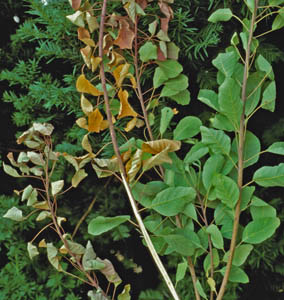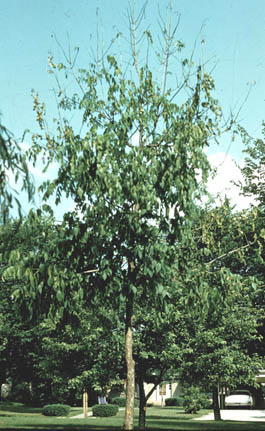Verticillium Wilt in 2008 | |
|---|---|
| September 18, 2008 | |
|
Verticillium wilt is a fungal disease that invades the water-conducting tissues of infected trees, causing blockage, resulting in death of branches or the entire tree. This disease may kill mature trees. The images show an affected and a healthy branch from smoketree Stressed plants are more susceptible to infection, so we expected to see an increase in Verticillium wilt cases this year as a result of root stress of 2007. The 2008 season started slowly with cool, wet weather. Flooding was an issue in some areas of Illinois; but in general, growing conditions were fine for trees. We started seeing tree stress in midsummer after several weeks of drought. So far this season, the Plant Clinic staff has isolated Verticillium from sugar maple, Japanese maple, three-flowered maple, red maple, ash, rudbeckia, and smoketree. Samples hailed from Champaign, DeKalb, Douglas, DuPage, Ford, Hamilton, Lake, Peoria, and Winnebago counties. There is no cure for Verticillium wilt. Still, there are many cultural and preventive strategies to manage the disease and maybe even help infected trees live with the fungus. Some disagree; but if you can catch infection early, branch removal and pampering may actually save a tree. Always start with healthy plants and avoid susceptible species. Supply balanced fertilization and provide adequate irrigation to improve the health of stressed plants. Remove dead wood to avoid problems with wood rots and decay. When dead wood is removed from an infected tree, it should be burned, not chipped, and not reused in the landscape. Because the disease is soil-borne, use only resistant species to replace Verticillium-infected plants. Some suggestions for replacement plants can be found in Report on Plant Disease, no. 1010, “Verticillium Wilt Disease,” available in Extension offices or on the Extension VISTA Web site, http://www.ag.uiuc.edu/%7Evista/horticul.htm. It is advantageous to control weeds in the landscape because many can serve as sources of inoculum. Dandelions, pigweed, horse nettle, and velvetleaf are all susceptible to Verticillium. Do not move soil from an infected area of the garden. This pathogen may be soil-borne and can survive for decades in the soil. Laboratories cannot positively identify this disease on a dead tree but can isolate the causal fungus from live, symptomatic wood. It takes about 7 to 10 days of incubation to make a positive ID in the lab. | |
| Author: | Nancy Pataky |


